Comprehensive Analysis of Antenna and Multiplexing Techniques in EE
VerifiedAdded on 2020/03/04
|8
|1510
|433
Homework Assignment
AI Summary
This document presents a comprehensive Q&A assignment focusing on antenna types and multiplexing techniques within the field of electrical engineering. The first section categorizes antennas based on frequency, aperture, radiation patterns, and polarization, providing examples such as directional, omnidirectional, horn, V-antennas, lens antennas, and parabolic reflectors, with an emphasis on their applications in wireless networks. The second part delves into multiplexing, specifically comparing CDMA and FDMA. It explains the concepts, usage, advantages, and disadvantages of each, highlighting their roles in modern communication systems. The document concludes with a list of relevant references supporting the analysis.

Q & A 1
Name:
Subject:
Professor’s Name:
Unit Name:
Date:
Name:
Subject:
Professor’s Name:
Unit Name:
Date:
Paraphrase This Document
Need a fresh take? Get an instant paraphrase of this document with our AI Paraphraser

Q & A 2
Contents
Answer 1......................................................................................................................................................3
Answer 2......................................................................................................................................................5
References...................................................................................................................................................8
Contents
Answer 1......................................................................................................................................................3
Answer 2......................................................................................................................................................5
References...................................................................................................................................................8
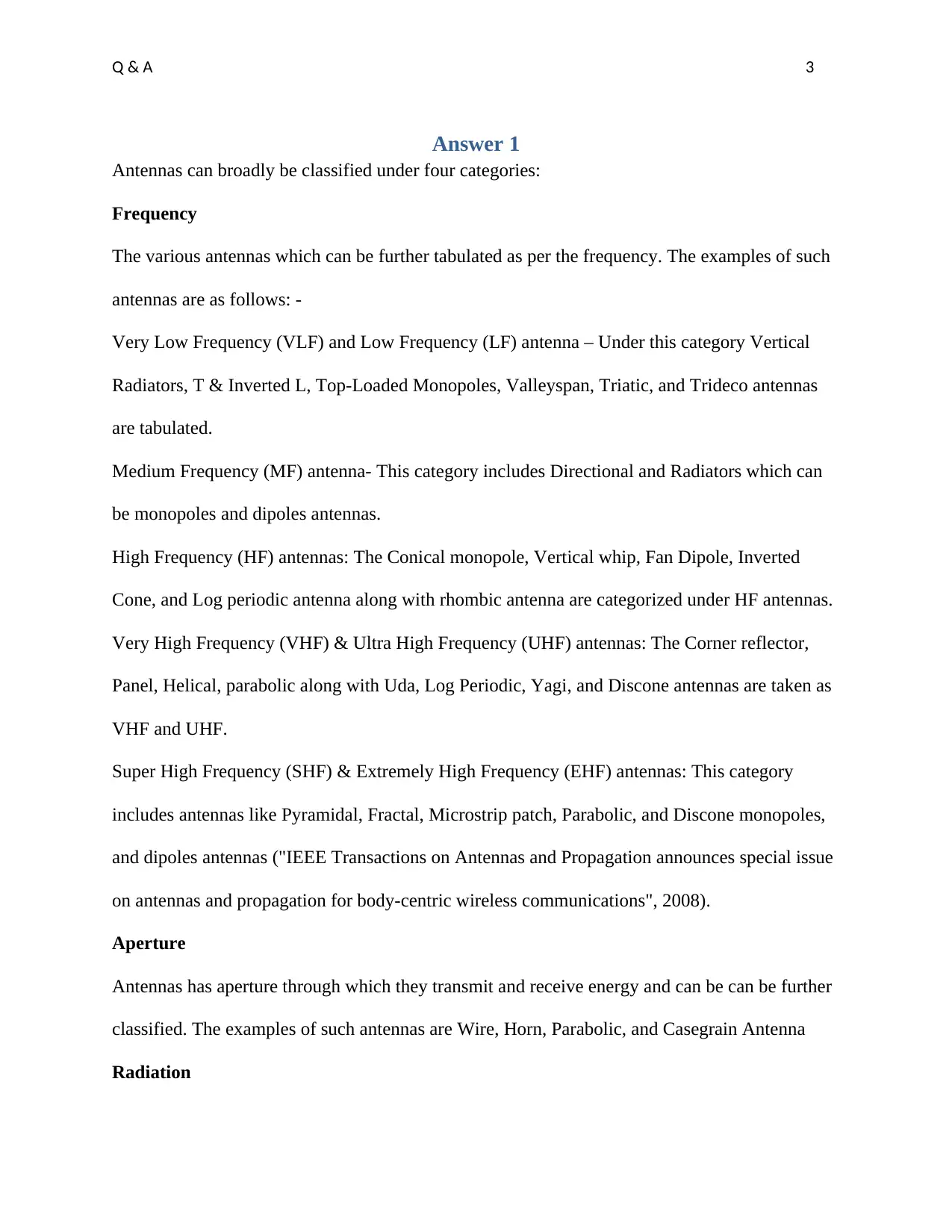
Q & A 3
Answer 1
Antennas can broadly be classified under four categories:
Frequency
The various antennas which can be further tabulated as per the frequency. The examples of such
antennas are as follows: -
Very Low Frequency (VLF) and Low Frequency (LF) antenna – Under this category Vertical
Radiators, T & Inverted L, Top-Loaded Monopoles, Valleyspan, Triatic, and Trideco antennas
are tabulated.
Medium Frequency (MF) antenna- This category includes Directional and Radiators which can
be monopoles and dipoles antennas.
High Frequency (HF) antennas: The Conical monopole, Vertical whip, Fan Dipole, Inverted
Cone, and Log periodic antenna along with rhombic antenna are categorized under HF antennas.
Very High Frequency (VHF) & Ultra High Frequency (UHF) antennas: The Corner reflector,
Panel, Helical, parabolic along with Uda, Log Periodic, Yagi, and Discone antennas are taken as
VHF and UHF.
Super High Frequency (SHF) & Extremely High Frequency (EHF) antennas: This category
includes antennas like Pyramidal, Fractal, Microstrip patch, Parabolic, and Discone monopoles,
and dipoles antennas ("IEEE Transactions on Antennas and Propagation announces special issue
on antennas and propagation for body-centric wireless communications", 2008).
Aperture
Antennas has aperture through which they transmit and receive energy and can be can be further
classified. The examples of such antennas are Wire, Horn, Parabolic, and Casegrain Antenna
Radiation
Answer 1
Antennas can broadly be classified under four categories:
Frequency
The various antennas which can be further tabulated as per the frequency. The examples of such
antennas are as follows: -
Very Low Frequency (VLF) and Low Frequency (LF) antenna – Under this category Vertical
Radiators, T & Inverted L, Top-Loaded Monopoles, Valleyspan, Triatic, and Trideco antennas
are tabulated.
Medium Frequency (MF) antenna- This category includes Directional and Radiators which can
be monopoles and dipoles antennas.
High Frequency (HF) antennas: The Conical monopole, Vertical whip, Fan Dipole, Inverted
Cone, and Log periodic antenna along with rhombic antenna are categorized under HF antennas.
Very High Frequency (VHF) & Ultra High Frequency (UHF) antennas: The Corner reflector,
Panel, Helical, parabolic along with Uda, Log Periodic, Yagi, and Discone antennas are taken as
VHF and UHF.
Super High Frequency (SHF) & Extremely High Frequency (EHF) antennas: This category
includes antennas like Pyramidal, Fractal, Microstrip patch, Parabolic, and Discone monopoles,
and dipoles antennas ("IEEE Transactions on Antennas and Propagation announces special issue
on antennas and propagation for body-centric wireless communications", 2008).
Aperture
Antennas has aperture through which they transmit and receive energy and can be can be further
classified. The examples of such antennas are Wire, Horn, Parabolic, and Casegrain Antenna
Radiation
⊘ This is a preview!⊘
Do you want full access?
Subscribe today to unlock all pages.

Trusted by 1+ million students worldwide
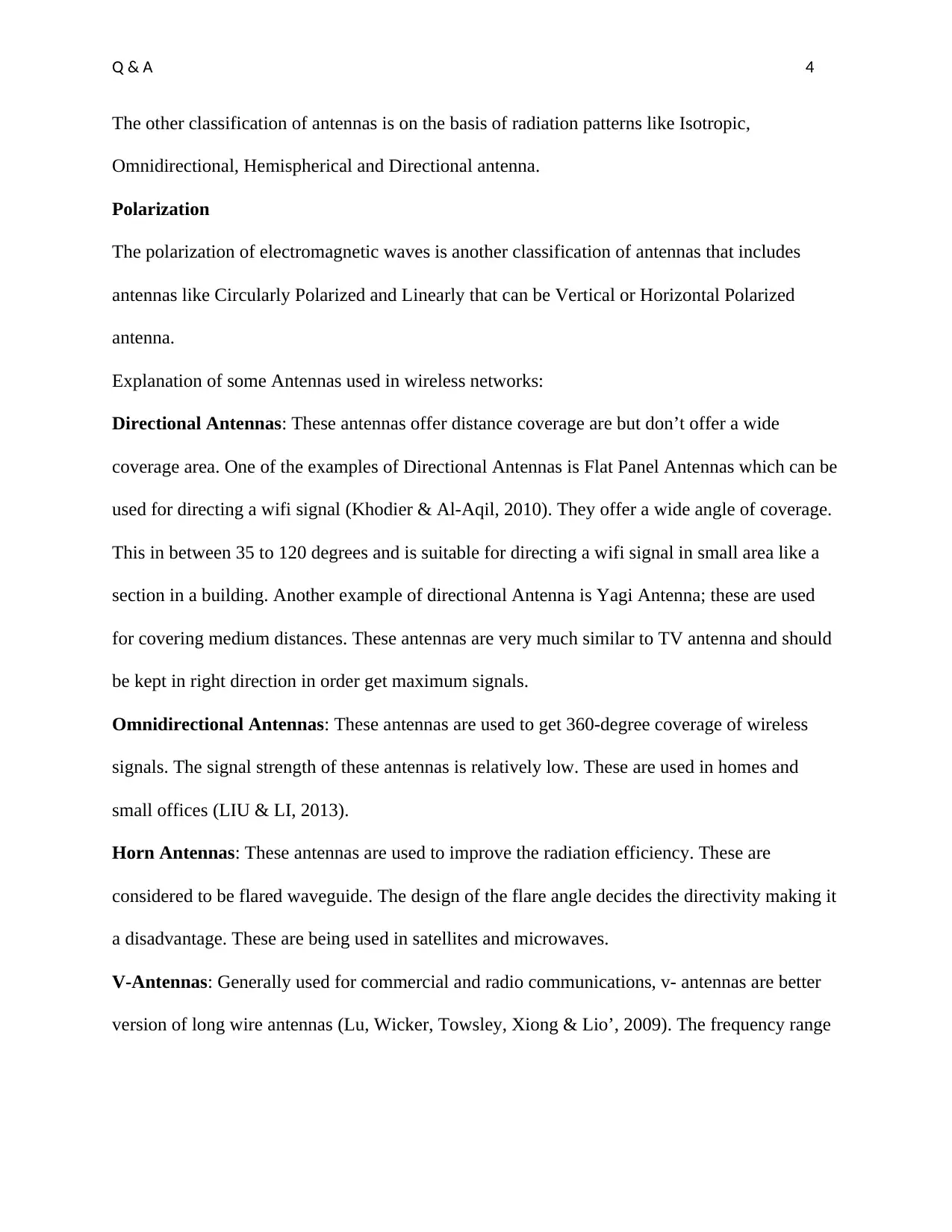
Q & A 4
The other classification of antennas is on the basis of radiation patterns like Isotropic,
Omnidirectional, Hemispherical and Directional antenna.
Polarization
The polarization of electromagnetic waves is another classification of antennas that includes
antennas like Circularly Polarized and Linearly that can be Vertical or Horizontal Polarized
antenna.
Explanation of some Antennas used in wireless networks:
Directional Antennas: These antennas offer distance coverage are but don’t offer a wide
coverage area. One of the examples of Directional Antennas is Flat Panel Antennas which can be
used for directing a wifi signal (Khodier & Al-Aqil, 2010). They offer a wide angle of coverage.
This in between 35 to 120 degrees and is suitable for directing a wifi signal in small area like a
section in a building. Another example of directional Antenna is Yagi Antenna; these are used
for covering medium distances. These antennas are very much similar to TV antenna and should
be kept in right direction in order get maximum signals.
Omnidirectional Antennas: These antennas are used to get 360-degree coverage of wireless
signals. The signal strength of these antennas is relatively low. These are used in homes and
small offices (LIU & LI, 2013).
Horn Antennas: These antennas are used to improve the radiation efficiency. These are
considered to be flared waveguide. The design of the flare angle decides the directivity making it
a disadvantage. These are being used in satellites and microwaves.
V-Antennas: Generally used for commercial and radio communications, v- antennas are better
version of long wire antennas (Lu, Wicker, Towsley, Xiong & Lio’, 2009). The frequency range
The other classification of antennas is on the basis of radiation patterns like Isotropic,
Omnidirectional, Hemispherical and Directional antenna.
Polarization
The polarization of electromagnetic waves is another classification of antennas that includes
antennas like Circularly Polarized and Linearly that can be Vertical or Horizontal Polarized
antenna.
Explanation of some Antennas used in wireless networks:
Directional Antennas: These antennas offer distance coverage are but don’t offer a wide
coverage area. One of the examples of Directional Antennas is Flat Panel Antennas which can be
used for directing a wifi signal (Khodier & Al-Aqil, 2010). They offer a wide angle of coverage.
This in between 35 to 120 degrees and is suitable for directing a wifi signal in small area like a
section in a building. Another example of directional Antenna is Yagi Antenna; these are used
for covering medium distances. These antennas are very much similar to TV antenna and should
be kept in right direction in order get maximum signals.
Omnidirectional Antennas: These antennas are used to get 360-degree coverage of wireless
signals. The signal strength of these antennas is relatively low. These are used in homes and
small offices (LIU & LI, 2013).
Horn Antennas: These antennas are used to improve the radiation efficiency. These are
considered to be flared waveguide. The design of the flare angle decides the directivity making it
a disadvantage. These are being used in satellites and microwaves.
V-Antennas: Generally used for commercial and radio communications, v- antennas are better
version of long wire antennas (Lu, Wicker, Towsley, Xiong & Lio’, 2009). The frequency range
Paraphrase This Document
Need a fresh take? Get an instant paraphrase of this document with our AI Paraphraser
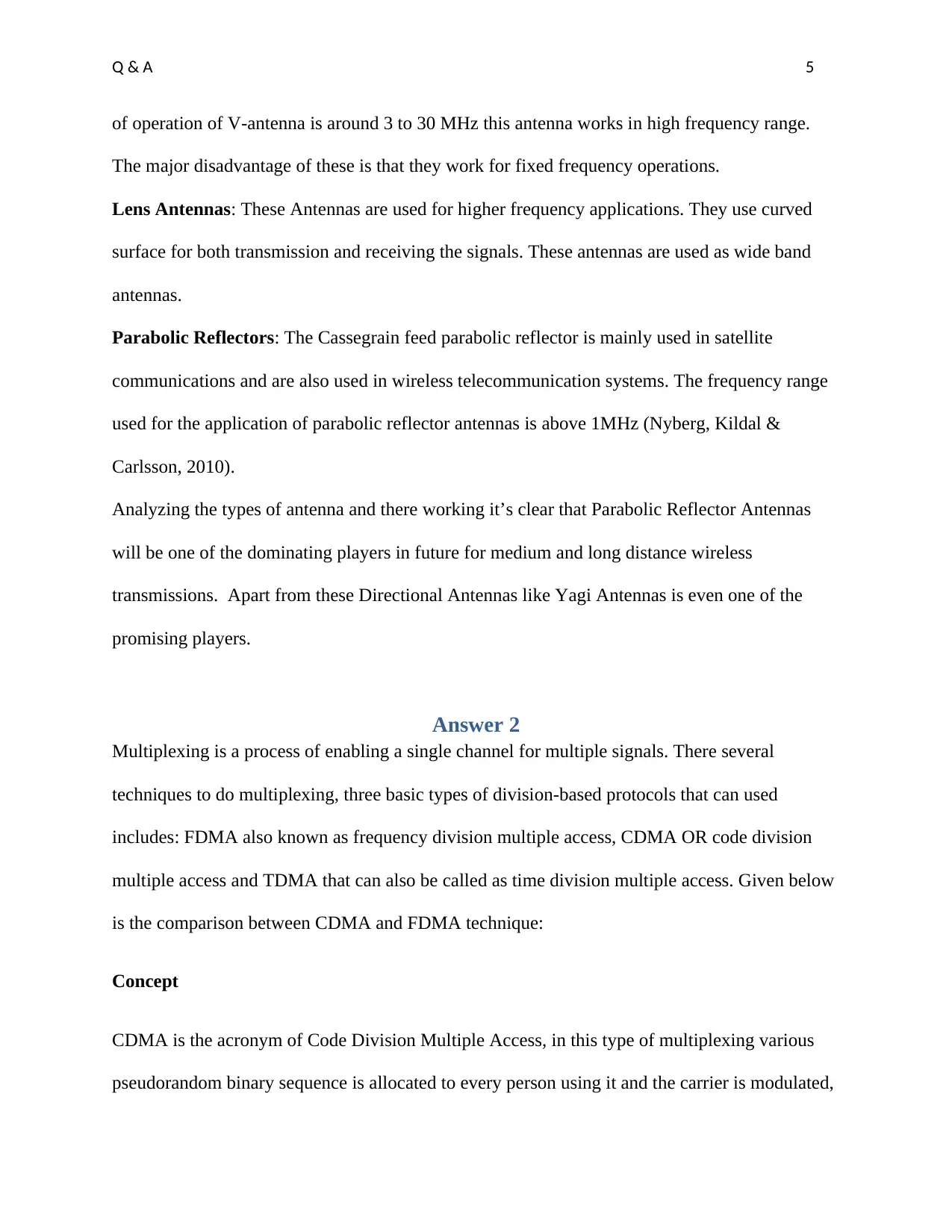
Q & A 5
of operation of V-antenna is around 3 to 30 MHz this antenna works in high frequency range.
The major disadvantage of these is that they work for fixed frequency operations.
Lens Antennas: These Antennas are used for higher frequency applications. They use curved
surface for both transmission and receiving the signals. These antennas are used as wide band
antennas.
Parabolic Reflectors: The Cassegrain feed parabolic reflector is mainly used in satellite
communications and are also used in wireless telecommunication systems. The frequency range
used for the application of parabolic reflector antennas is above 1MHz (Nyberg, Kildal &
Carlsson, 2010).
Analyzing the types of antenna and there working it’s clear that Parabolic Reflector Antennas
will be one of the dominating players in future for medium and long distance wireless
transmissions. Apart from these Directional Antennas like Yagi Antennas is even one of the
promising players.
Answer 2
Multiplexing is a process of enabling a single channel for multiple signals. There several
techniques to do multiplexing, three basic types of division-based protocols that can used
includes: FDMA also known as frequency division multiple access, CDMA OR code division
multiple access and TDMA that can also be called as time division multiple access. Given below
is the comparison between CDMA and FDMA technique:
Concept
CDMA is the acronym of Code Division Multiple Access, in this type of multiplexing various
pseudorandom binary sequence is allocated to every person using it and the carrier is modulated,
of operation of V-antenna is around 3 to 30 MHz this antenna works in high frequency range.
The major disadvantage of these is that they work for fixed frequency operations.
Lens Antennas: These Antennas are used for higher frequency applications. They use curved
surface for both transmission and receiving the signals. These antennas are used as wide band
antennas.
Parabolic Reflectors: The Cassegrain feed parabolic reflector is mainly used in satellite
communications and are also used in wireless telecommunication systems. The frequency range
used for the application of parabolic reflector antennas is above 1MHz (Nyberg, Kildal &
Carlsson, 2010).
Analyzing the types of antenna and there working it’s clear that Parabolic Reflector Antennas
will be one of the dominating players in future for medium and long distance wireless
transmissions. Apart from these Directional Antennas like Yagi Antennas is even one of the
promising players.
Answer 2
Multiplexing is a process of enabling a single channel for multiple signals. There several
techniques to do multiplexing, three basic types of division-based protocols that can used
includes: FDMA also known as frequency division multiple access, CDMA OR code division
multiple access and TDMA that can also be called as time division multiple access. Given below
is the comparison between CDMA and FDMA technique:
Concept
CDMA is the acronym of Code Division Multiple Access, in this type of multiplexing various
pseudorandom binary sequence is allocated to every person using it and the carrier is modulated,
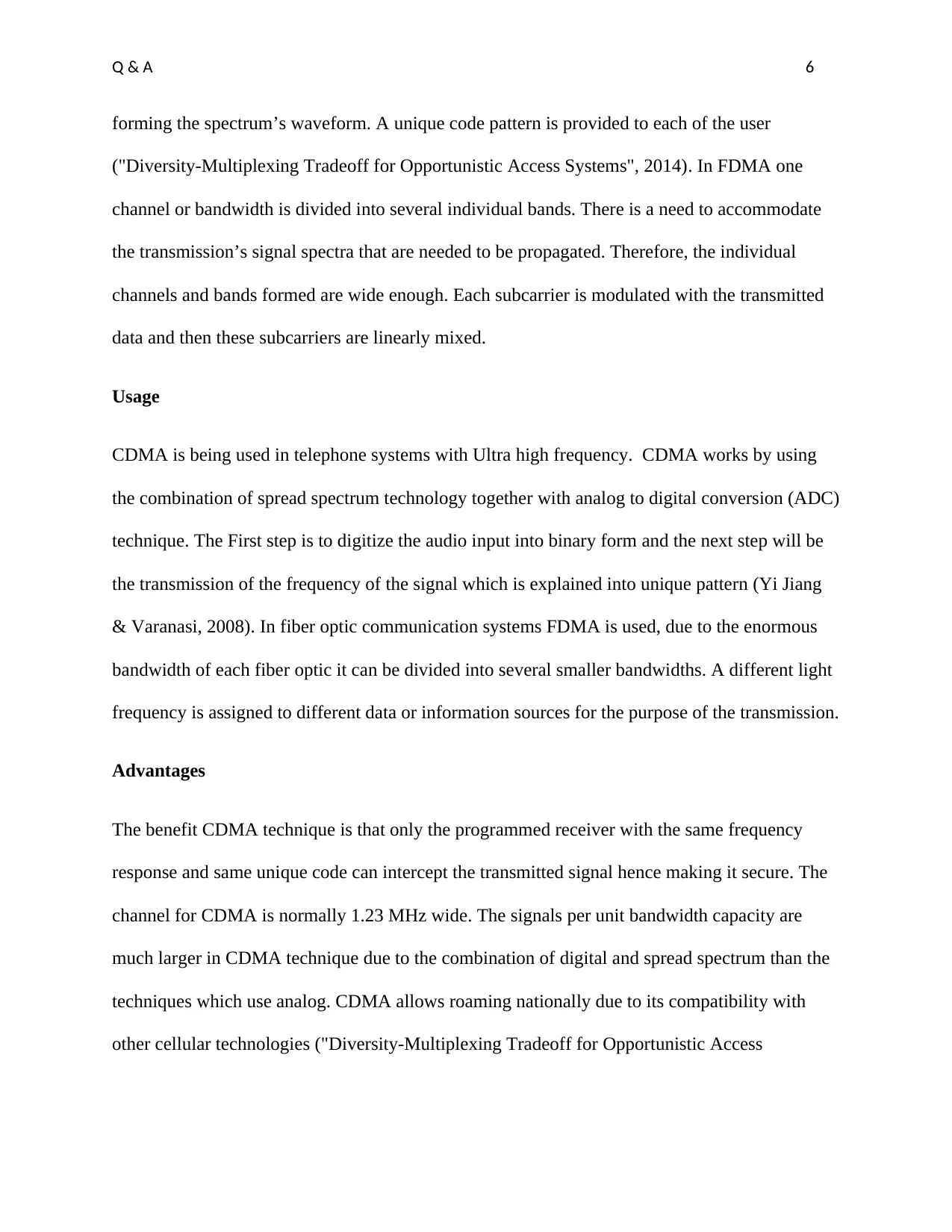
Q & A 6
forming the spectrum’s waveform. A unique code pattern is provided to each of the user
("Diversity-Multiplexing Tradeoff for Opportunistic Access Systems", 2014). In FDMA one
channel or bandwidth is divided into several individual bands. There is a need to accommodate
the transmission’s signal spectra that are needed to be propagated. Therefore, the individual
channels and bands formed are wide enough. Each subcarrier is modulated with the transmitted
data and then these subcarriers are linearly mixed.
Usage
CDMA is being used in telephone systems with Ultra high frequency. CDMA works by using
the combination of spread spectrum technology together with analog to digital conversion (ADC)
technique. The First step is to digitize the audio input into binary form and the next step will be
the transmission of the frequency of the signal which is explained into unique pattern (Yi Jiang
& Varanasi, 2008). In fiber optic communication systems FDMA is used, due to the enormous
bandwidth of each fiber optic it can be divided into several smaller bandwidths. A different light
frequency is assigned to different data or information sources for the purpose of the transmission.
Advantages
The benefit CDMA technique is that only the programmed receiver with the same frequency
response and same unique code can intercept the transmitted signal hence making it secure. The
channel for CDMA is normally 1.23 MHz wide. The signals per unit bandwidth capacity are
much larger in CDMA technique due to the combination of digital and spread spectrum than the
techniques which use analog. CDMA allows roaming nationally due to its compatibility with
other cellular technologies ("Diversity-Multiplexing Tradeoff for Opportunistic Access
forming the spectrum’s waveform. A unique code pattern is provided to each of the user
("Diversity-Multiplexing Tradeoff for Opportunistic Access Systems", 2014). In FDMA one
channel or bandwidth is divided into several individual bands. There is a need to accommodate
the transmission’s signal spectra that are needed to be propagated. Therefore, the individual
channels and bands formed are wide enough. Each subcarrier is modulated with the transmitted
data and then these subcarriers are linearly mixed.
Usage
CDMA is being used in telephone systems with Ultra high frequency. CDMA works by using
the combination of spread spectrum technology together with analog to digital conversion (ADC)
technique. The First step is to digitize the audio input into binary form and the next step will be
the transmission of the frequency of the signal which is explained into unique pattern (Yi Jiang
& Varanasi, 2008). In fiber optic communication systems FDMA is used, due to the enormous
bandwidth of each fiber optic it can be divided into several smaller bandwidths. A different light
frequency is assigned to different data or information sources for the purpose of the transmission.
Advantages
The benefit CDMA technique is that only the programmed receiver with the same frequency
response and same unique code can intercept the transmitted signal hence making it secure. The
channel for CDMA is normally 1.23 MHz wide. The signals per unit bandwidth capacity are
much larger in CDMA technique due to the combination of digital and spread spectrum than the
techniques which use analog. CDMA allows roaming nationally due to its compatibility with
other cellular technologies ("Diversity-Multiplexing Tradeoff for Opportunistic Access
⊘ This is a preview!⊘
Do you want full access?
Subscribe today to unlock all pages.

Trusted by 1+ million students worldwide
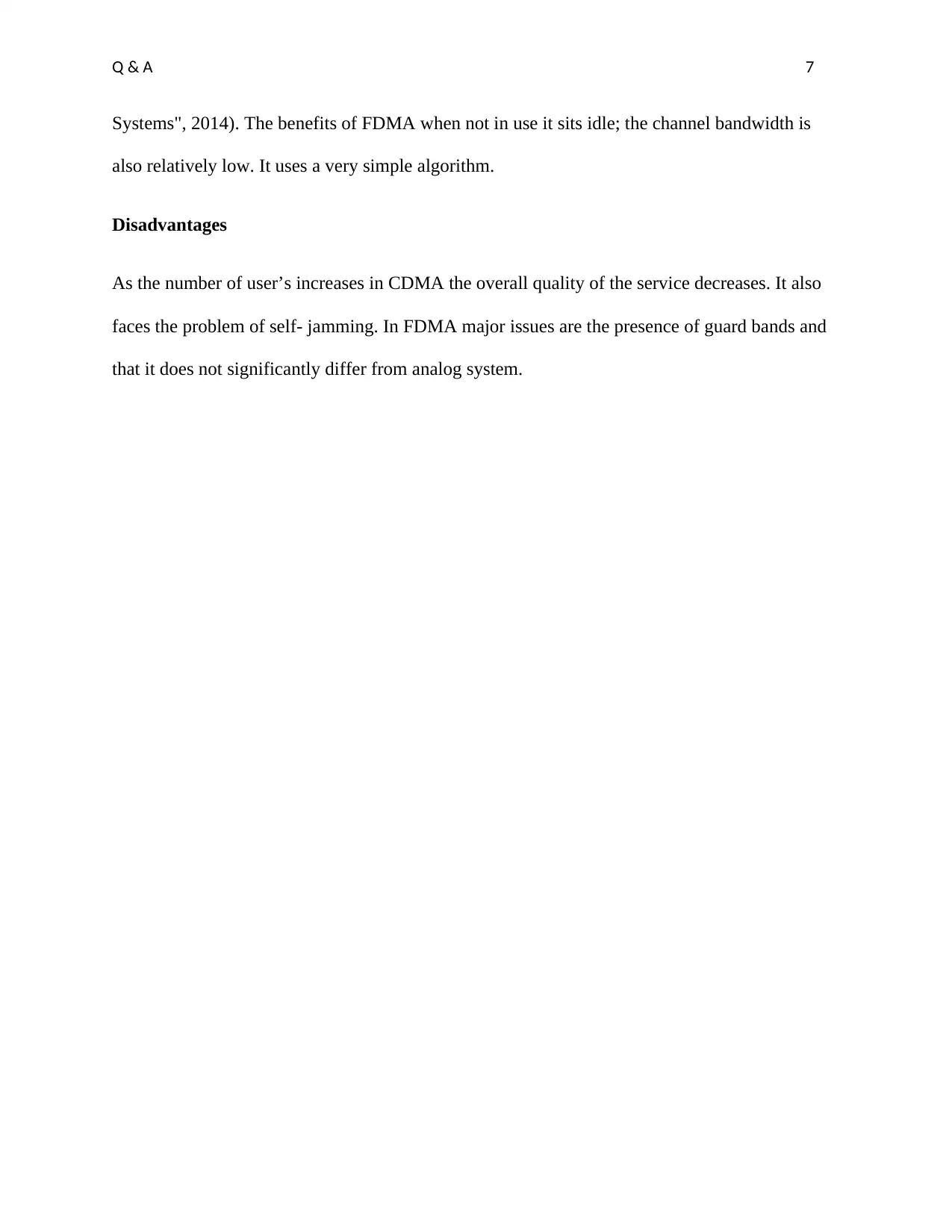
Q & A 7
Systems", 2014). The benefits of FDMA when not in use it sits idle; the channel bandwidth is
also relatively low. It uses a very simple algorithm.
Disadvantages
As the number of user’s increases in CDMA the overall quality of the service decreases. It also
faces the problem of self- jamming. In FDMA major issues are the presence of guard bands and
that it does not significantly differ from analog system.
Systems", 2014). The benefits of FDMA when not in use it sits idle; the channel bandwidth is
also relatively low. It uses a very simple algorithm.
Disadvantages
As the number of user’s increases in CDMA the overall quality of the service decreases. It also
faces the problem of self- jamming. In FDMA major issues are the presence of guard bands and
that it does not significantly differ from analog system.
Paraphrase This Document
Need a fresh take? Get an instant paraphrase of this document with our AI Paraphraser
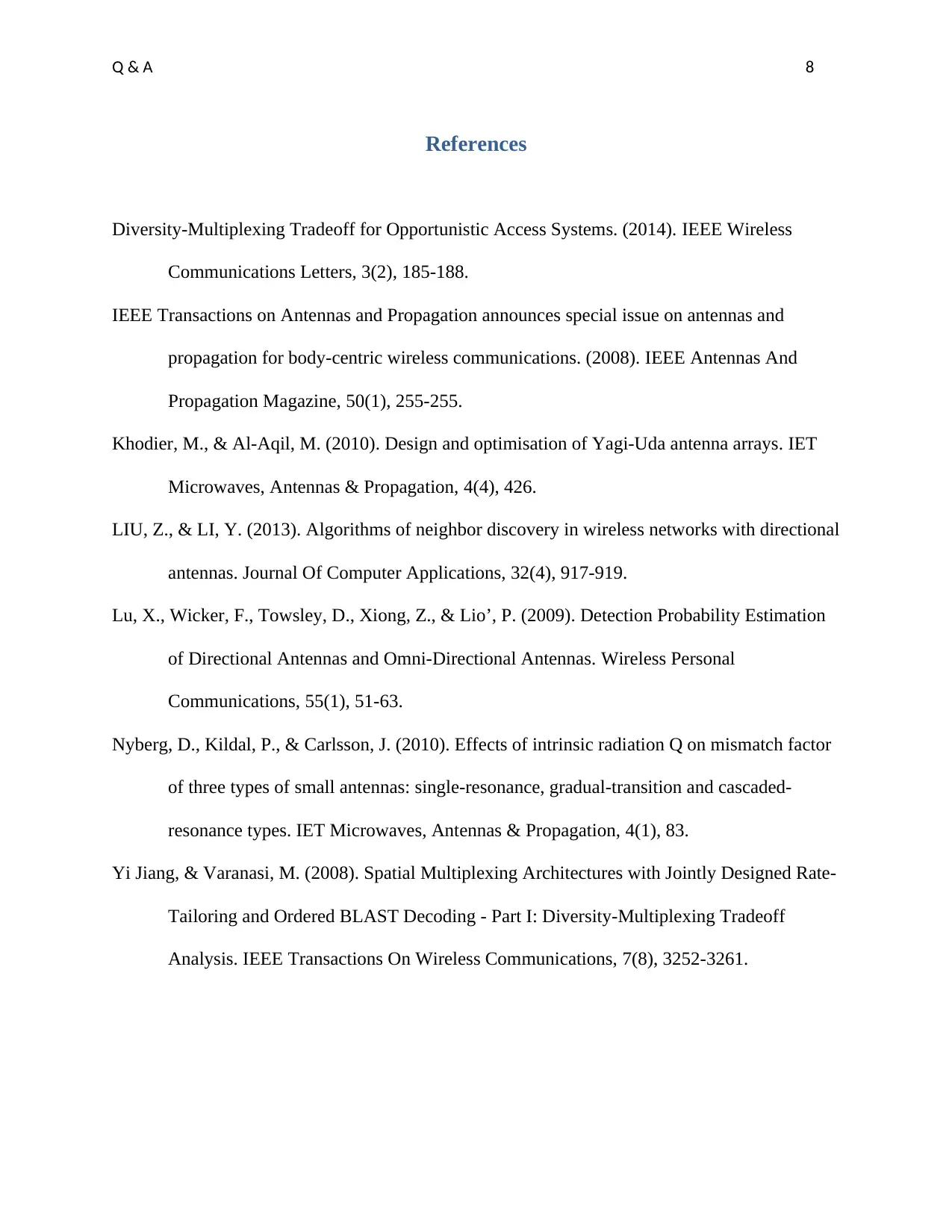
Q & A 8
References
Diversity-Multiplexing Tradeoff for Opportunistic Access Systems. (2014). IEEE Wireless
Communications Letters, 3(2), 185-188.
IEEE Transactions on Antennas and Propagation announces special issue on antennas and
propagation for body-centric wireless communications. (2008). IEEE Antennas And
Propagation Magazine, 50(1), 255-255.
Khodier, M., & Al-Aqil, M. (2010). Design and optimisation of Yagi-Uda antenna arrays. IET
Microwaves, Antennas & Propagation, 4(4), 426.
LIU, Z., & LI, Y. (2013). Algorithms of neighbor discovery in wireless networks with directional
antennas. Journal Of Computer Applications, 32(4), 917-919.
Lu, X., Wicker, F., Towsley, D., Xiong, Z., & Lio’, P. (2009). Detection Probability Estimation
of Directional Antennas and Omni-Directional Antennas. Wireless Personal
Communications, 55(1), 51-63.
Nyberg, D., Kildal, P., & Carlsson, J. (2010). Effects of intrinsic radiation Q on mismatch factor
of three types of small antennas: single-resonance, gradual-transition and cascaded-
resonance types. IET Microwaves, Antennas & Propagation, 4(1), 83.
Yi Jiang, & Varanasi, M. (2008). Spatial Multiplexing Architectures with Jointly Designed Rate-
Tailoring and Ordered BLAST Decoding - Part I: Diversity-Multiplexing Tradeoff
Analysis. IEEE Transactions On Wireless Communications, 7(8), 3252-3261.
References
Diversity-Multiplexing Tradeoff for Opportunistic Access Systems. (2014). IEEE Wireless
Communications Letters, 3(2), 185-188.
IEEE Transactions on Antennas and Propagation announces special issue on antennas and
propagation for body-centric wireless communications. (2008). IEEE Antennas And
Propagation Magazine, 50(1), 255-255.
Khodier, M., & Al-Aqil, M. (2010). Design and optimisation of Yagi-Uda antenna arrays. IET
Microwaves, Antennas & Propagation, 4(4), 426.
LIU, Z., & LI, Y. (2013). Algorithms of neighbor discovery in wireless networks with directional
antennas. Journal Of Computer Applications, 32(4), 917-919.
Lu, X., Wicker, F., Towsley, D., Xiong, Z., & Lio’, P. (2009). Detection Probability Estimation
of Directional Antennas and Omni-Directional Antennas. Wireless Personal
Communications, 55(1), 51-63.
Nyberg, D., Kildal, P., & Carlsson, J. (2010). Effects of intrinsic radiation Q on mismatch factor
of three types of small antennas: single-resonance, gradual-transition and cascaded-
resonance types. IET Microwaves, Antennas & Propagation, 4(1), 83.
Yi Jiang, & Varanasi, M. (2008). Spatial Multiplexing Architectures with Jointly Designed Rate-
Tailoring and Ordered BLAST Decoding - Part I: Diversity-Multiplexing Tradeoff
Analysis. IEEE Transactions On Wireless Communications, 7(8), 3252-3261.
1 out of 8
Related Documents
Your All-in-One AI-Powered Toolkit for Academic Success.
+13062052269
info@desklib.com
Available 24*7 on WhatsApp / Email
![[object Object]](/_next/static/media/star-bottom.7253800d.svg)
Unlock your academic potential
Copyright © 2020–2025 A2Z Services. All Rights Reserved. Developed and managed by ZUCOL.





